Infrared Filter Options
At this time, we have seven infrared filters to choose from for your conversion: 550nm, 590nm, 665nm, 720nm, 850nm, Blue IR/NDVI, and full spectrum. Depending on your color preference and shooting style, you may prefer one wavelength over another. Read on to discover more about each option, or see the chart below for a full visual comparison.
550nm ir filter
Inspired by false color IR film, the 550nm ir filter can produce deep blue skies and pink or crimson reds, making for striking landscapes.
When to use this filter: Like the 590nm but with a twist, this filter is excellent for producing attention-grabbing landscapes. It’s also a surprisingly good choice for infrared portraits since it maintains more neutral skin tones than the 590nm ir filter without exposing veins and still providing striking false color, but not as good as our IR Chrome. This filter requires post-processing and a full spectrum converted camera.
Available as:
590nm ir filter
The 590nm infrared filter can produce vibrant false colors while allowing for flexibility in post-processing.
When to use this filter: Typically used to produce golden-yellow foliage and bright blue skies. This filter requires post-processing and is compatible with a full spectrum camera or a lower cutoff IR converted camera.
Available as:
665nm ir filter
665nm is the sweet spot between 590nm and 720nm, producing vibrant false colors with good black and white contrast.
When to use this filter: Typically used to produce light yellow leaves or the classic white IR look with blue skies. This filter requires post-processing and is compatible with a full spectrum or a lower cutoff IR converted camera.
Available as:
720nm (Standard Infrared Filter)
This is the tried-and-true classic IR filter. It allows for some great blue sky false color and provides great contrast and dynamic range for black and white. This is equivalent to the Hoya R72 and Wratten 89b.
When to use this filter: This filter is good if you are interested in shooting some mild color and black and white. This filter produces the traditional dark blue skies and can also be processed for color.
While not as high contrast as the 850nm, people prefer this filter over the 850nm for B&W work, as it allows a little more color for B&W processing. This filter requires post-processing and is compatible with a full spectrum camera or a lower cutoff IR converted camera. This filter can also be used with stock cameras with a long exposure.
Available as:
850nm (Black and White Infrared Filter)
This filter is suitable for a dedicated black and white infrared camera. It will produce bright whites and pronounced darks. With a custom white balance in camera, the picture is close to pure B&W without any processing. Equivalent to the Wratten 87c.
When to use this filter: This filter is the best for the highest contrast B&W, resembling traditional B&W IR film. Also good for forensics and other applications where the deep IR wavelengths are helpful. This filter is compatible with a full spectrum camera or a lower cutoff IR converted camera. This filter can also be used with some stock cameras with a long exposure.
Available as:
The NDVI Blue IR filter (Blue + IR)
This filter transmits both blue and IR, making it ideal for NDVI crop analysis applications. It allows an NDVI to be generated from a single image using the blue and red channels of the image.
When to use this filter: Good for crop analysis purposes and a false color IR without post-processing. Due to the multiple bands the lens has to focus with this filter, the images are less sharp than they can be with the dedicated IR filters.
Available as:
The Full Spectrum filter (clear glass)
Full spectrum glass makes the camera sensitive to UV, visible, and IR light, allowing switching between various external filters to achieve the desired effect. This allows going between infrared and regular shooting with one camera; however, opaque infrared filters block composition on DSLRs without a live view function.
Available as:
We have these infrared filters and six others available in external filters as well for use with a full spectrum conversion.
Custom White Balance | Channel Swapped | Black & White | Direct from Camera, Auto White Balance | |
|---|---|---|---|---|
550nm Filter
| 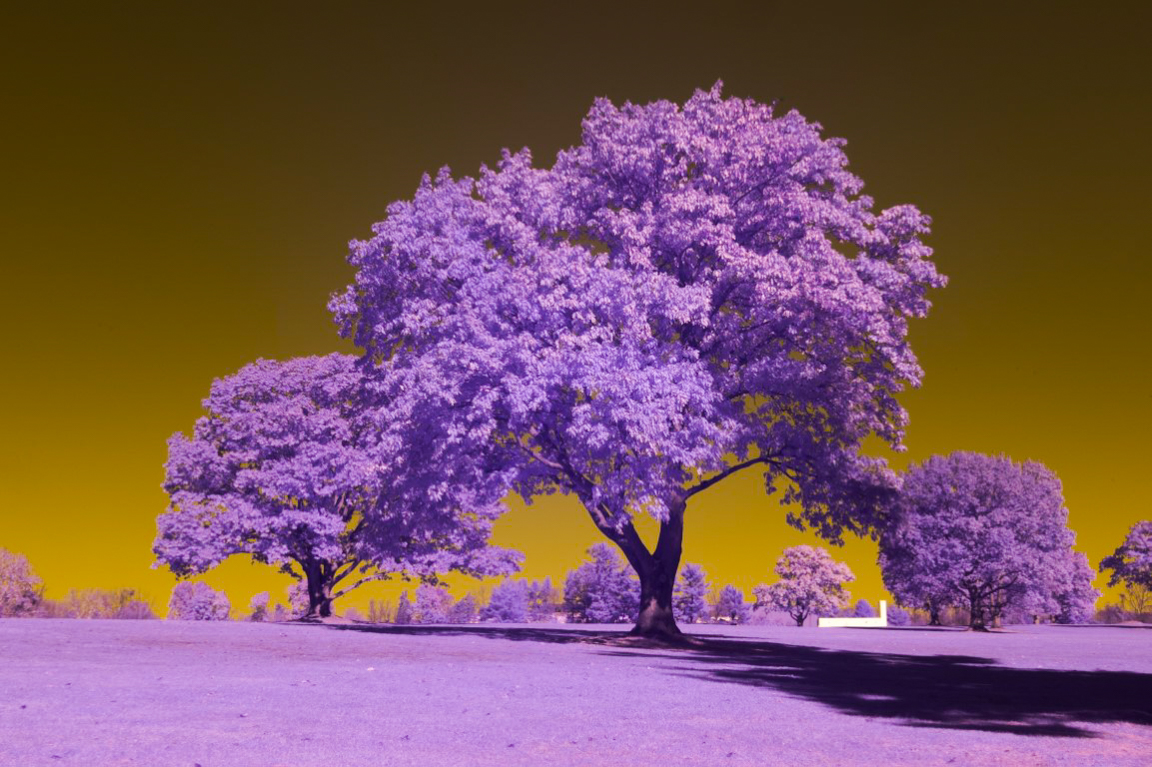 | 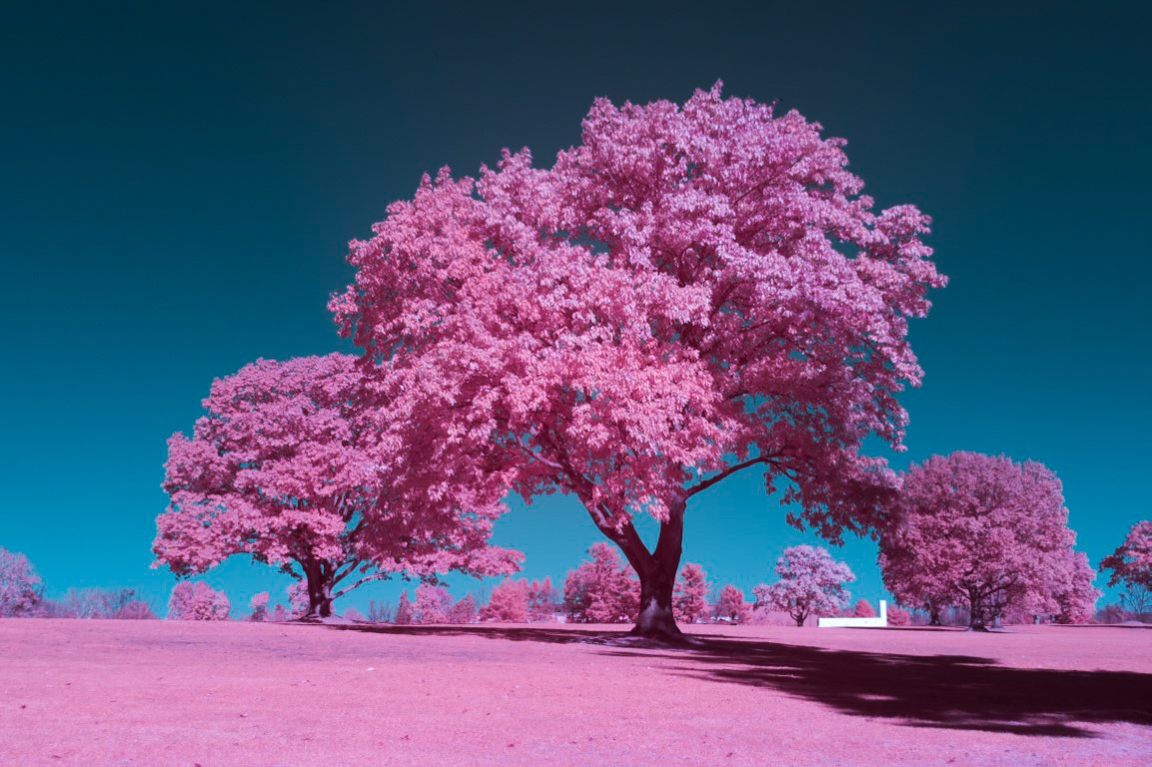 | 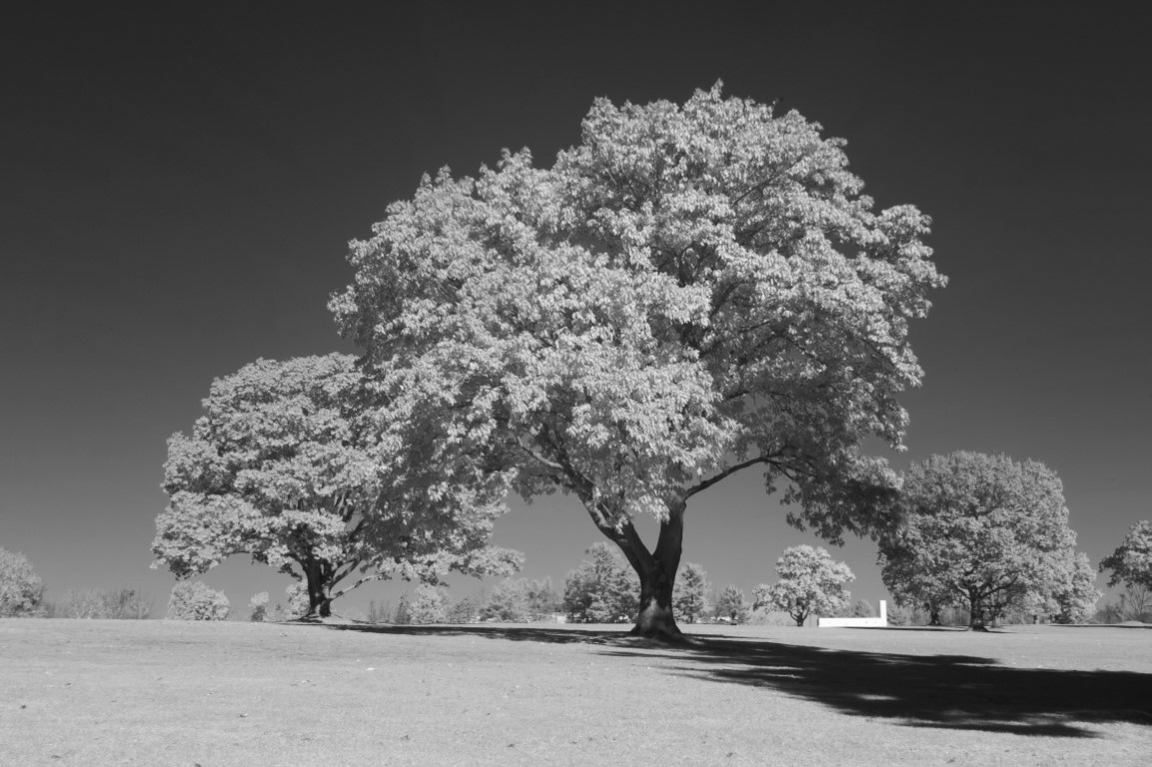 |  |
590nm Filter | 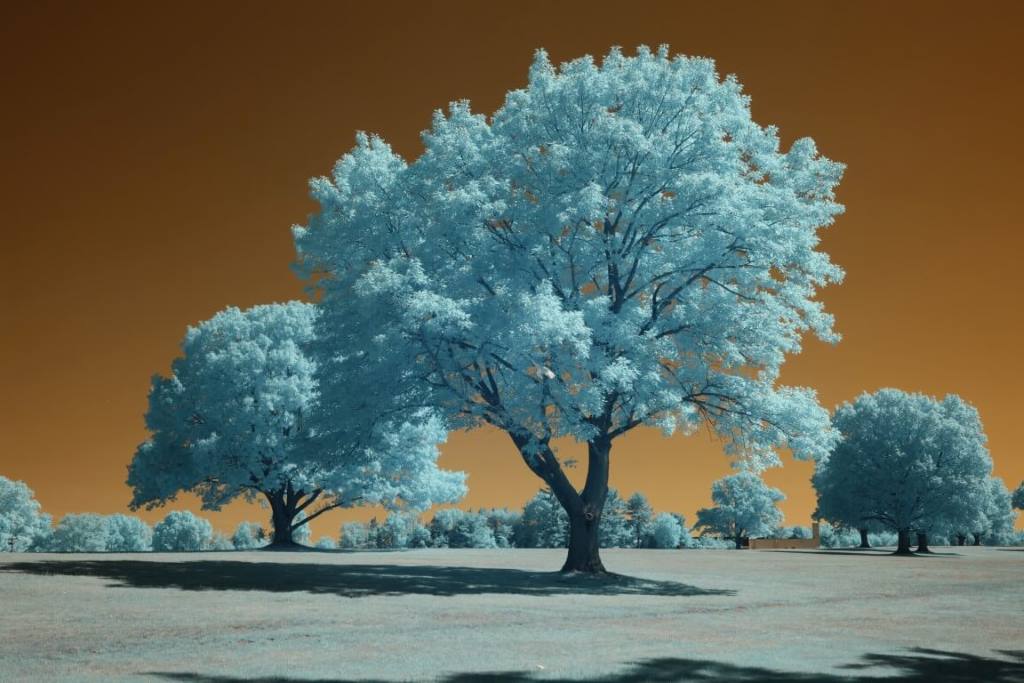 | 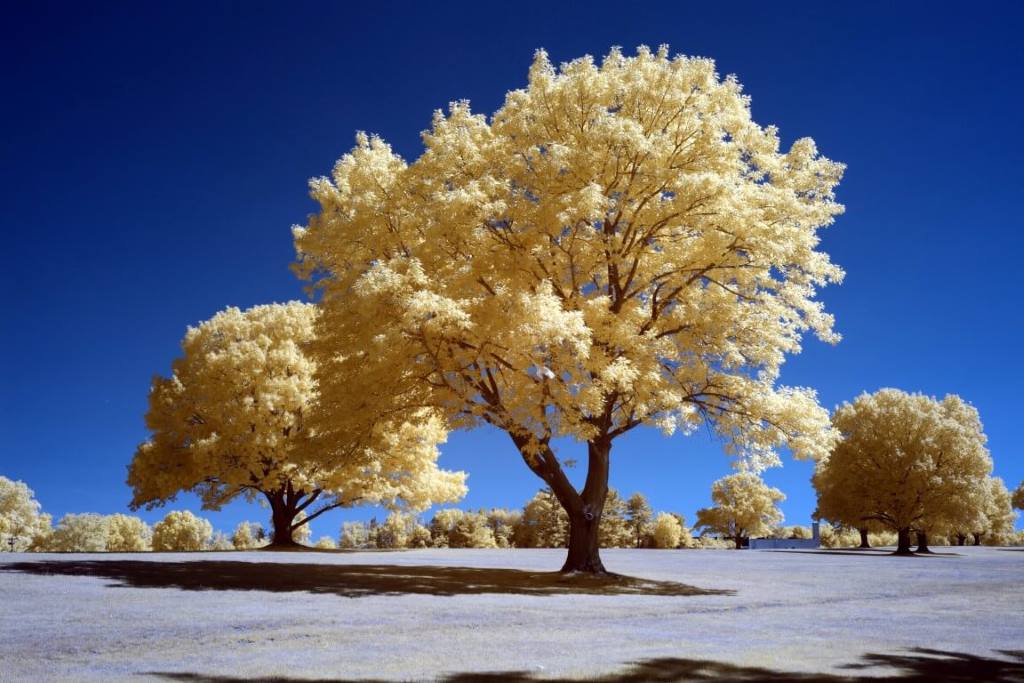 | 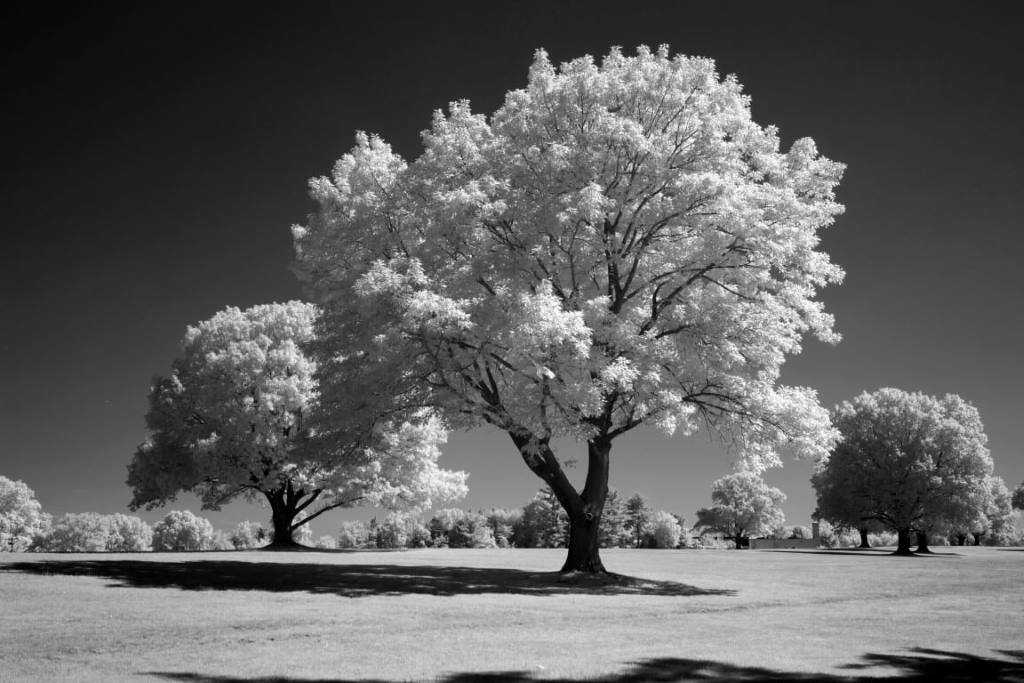 | 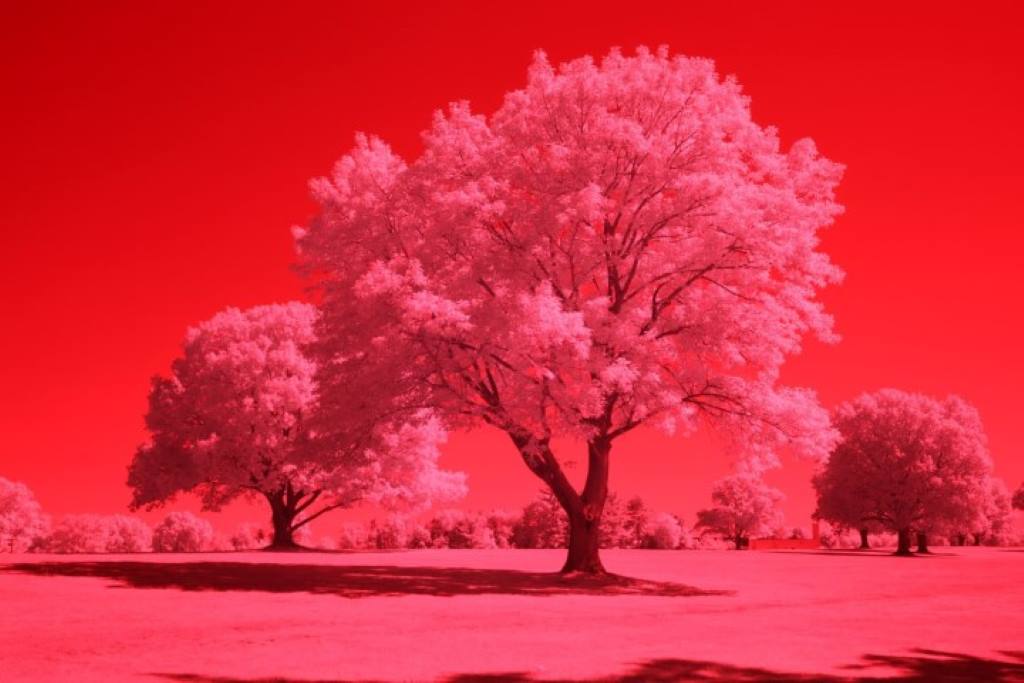 |
665nm Filter | 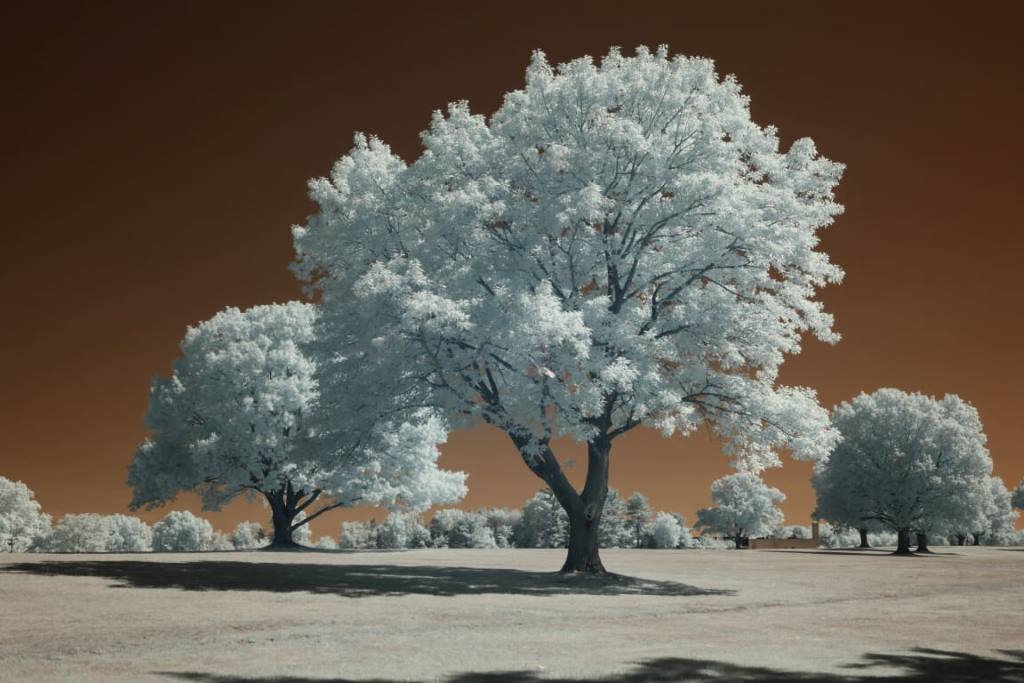 | 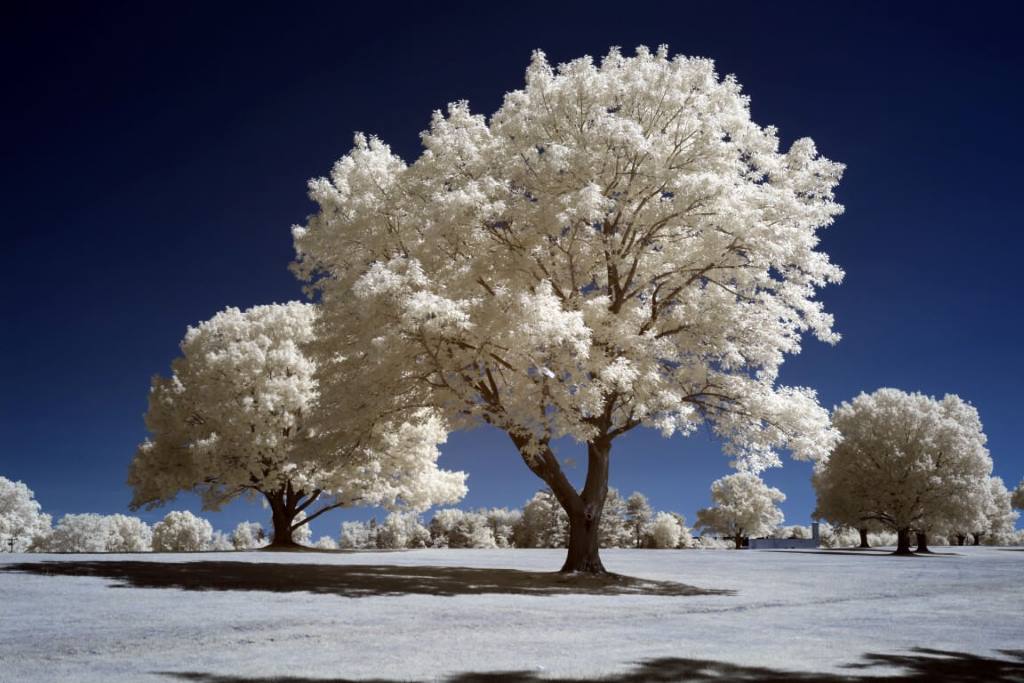 | 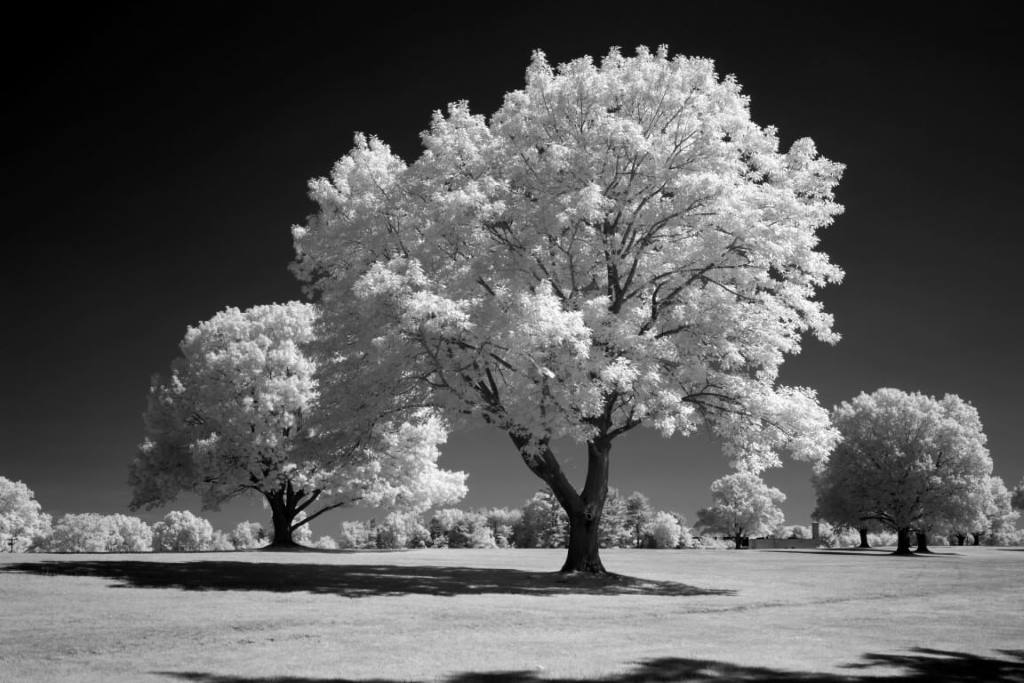 |  |
720nm Filter | 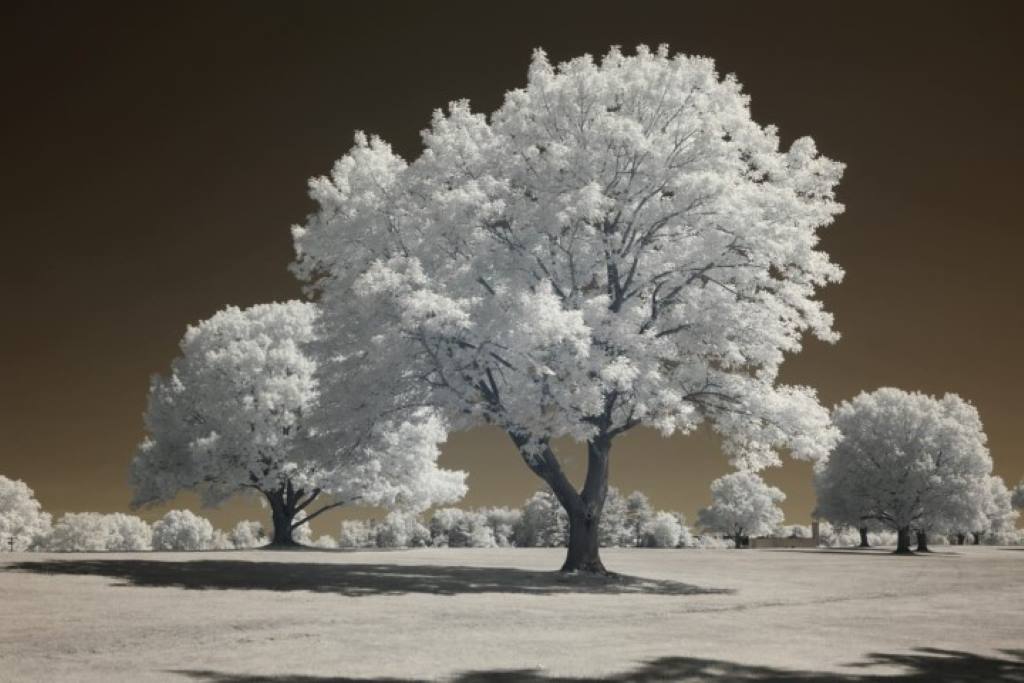 |  | 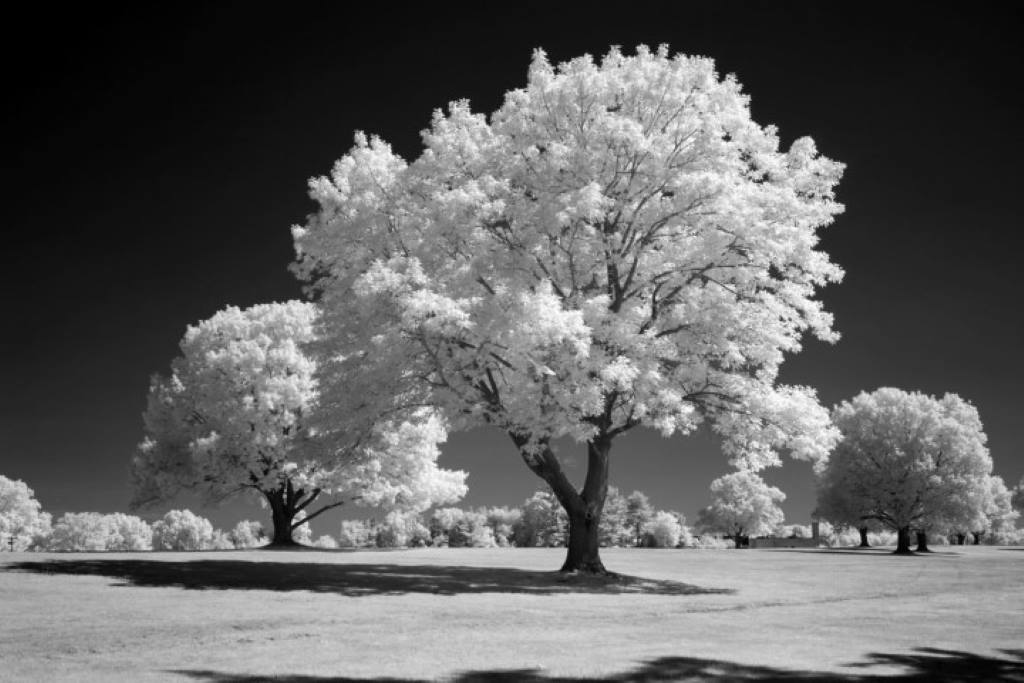 | 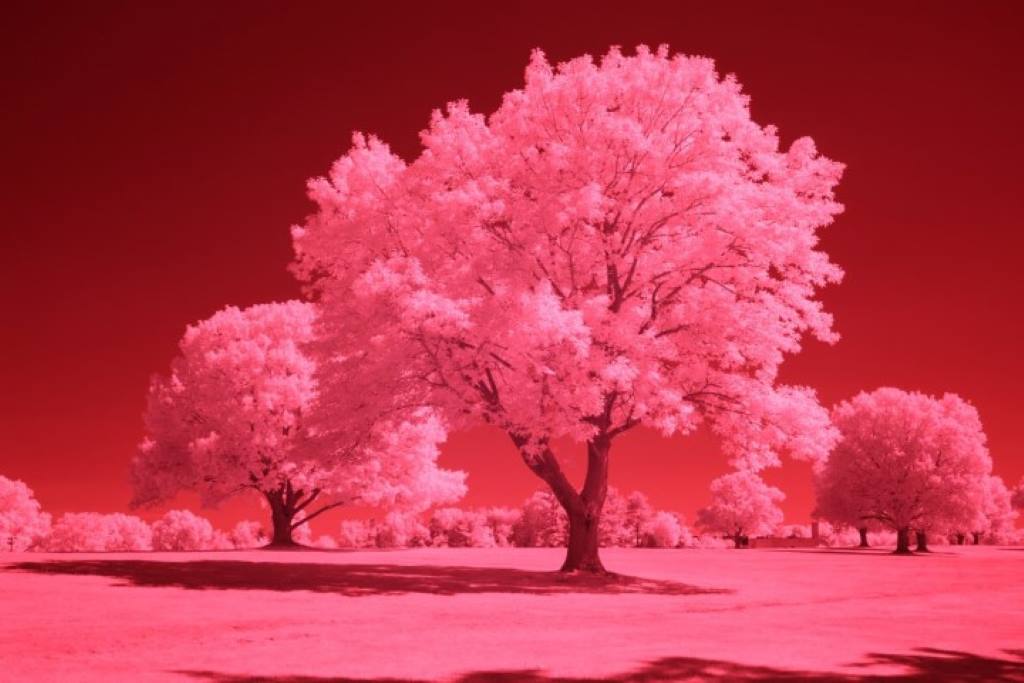 |
780nm Filter | 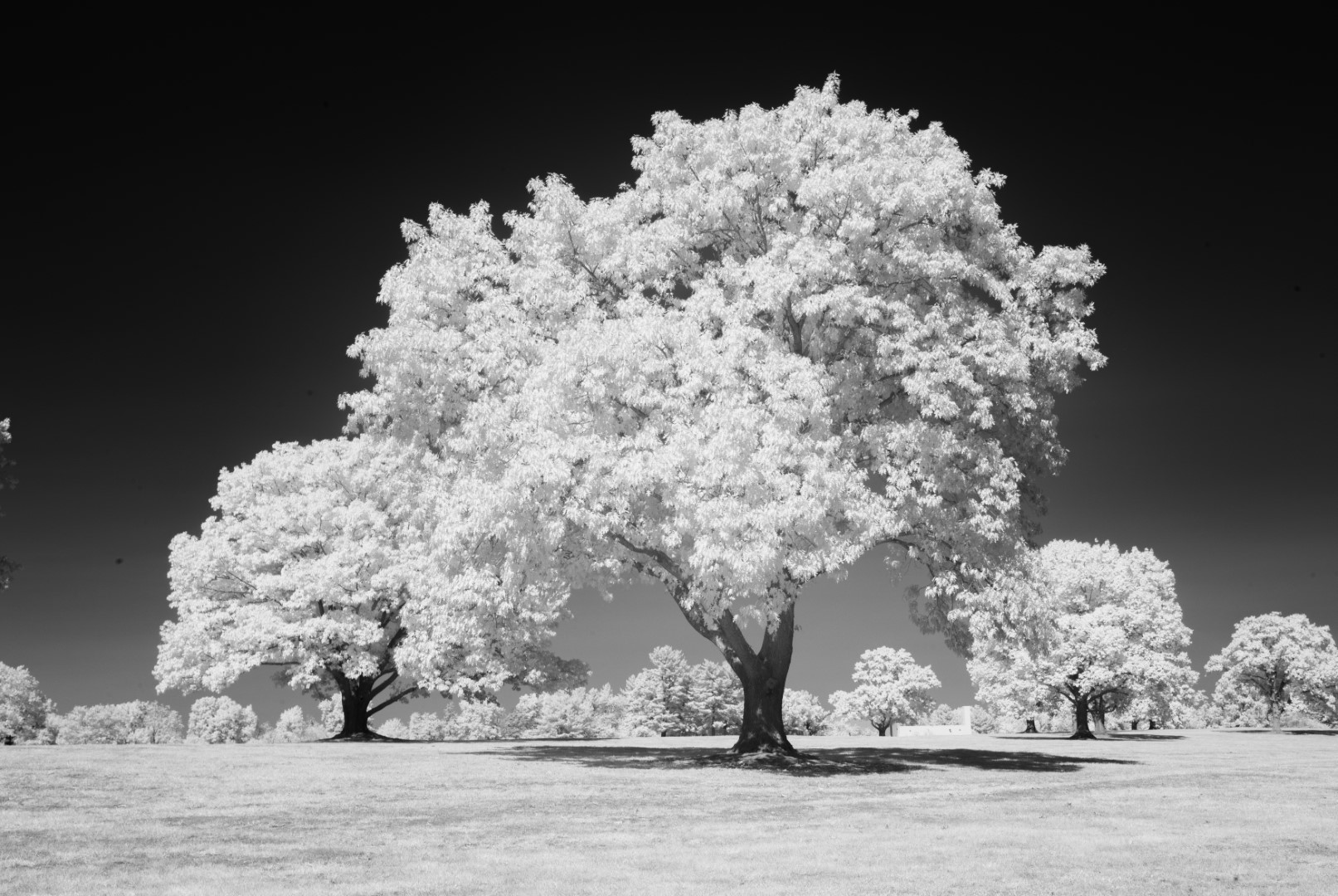 | N/A |  | 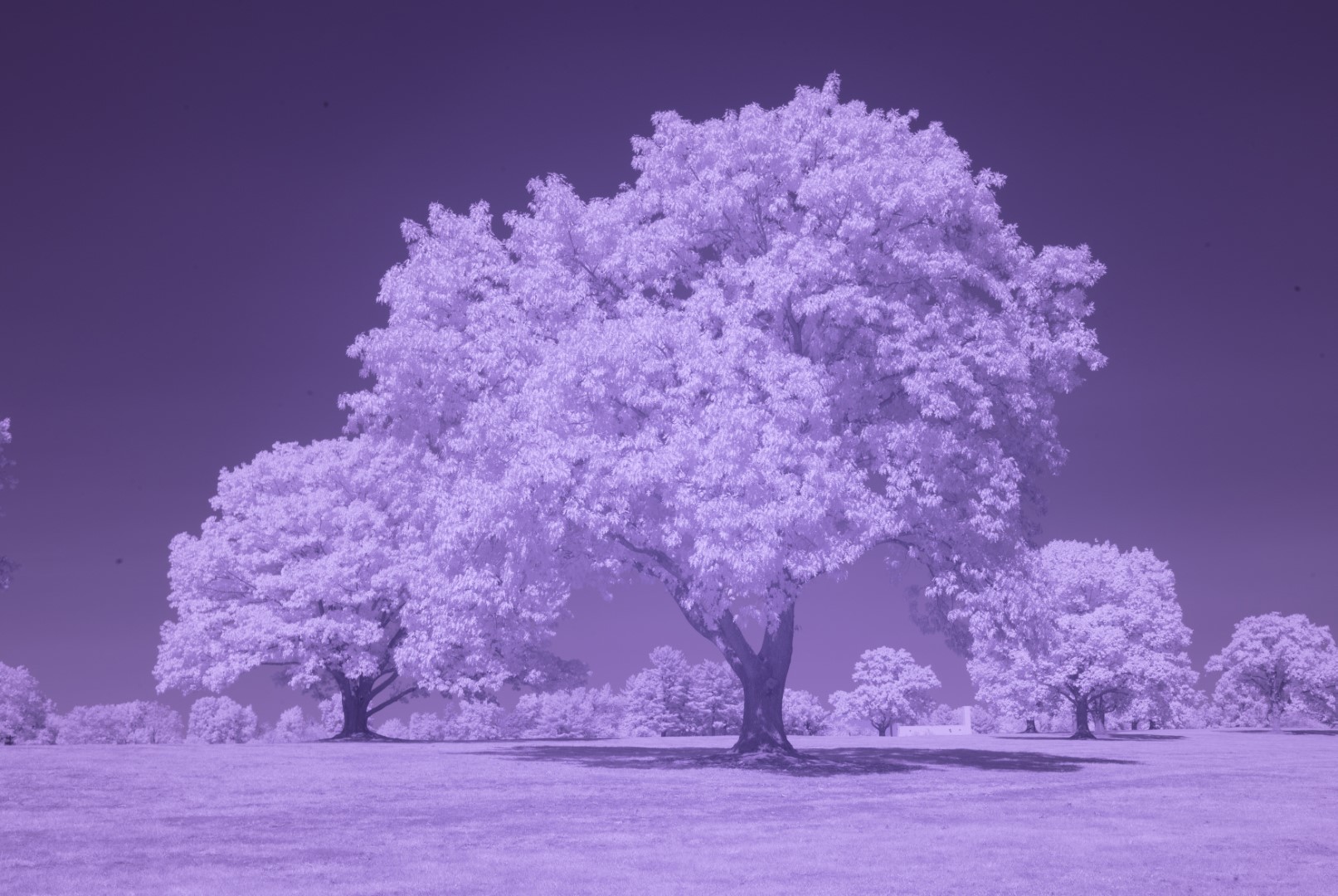 |
850nm Filter |  | N/A |  |  |
930nm Filter | 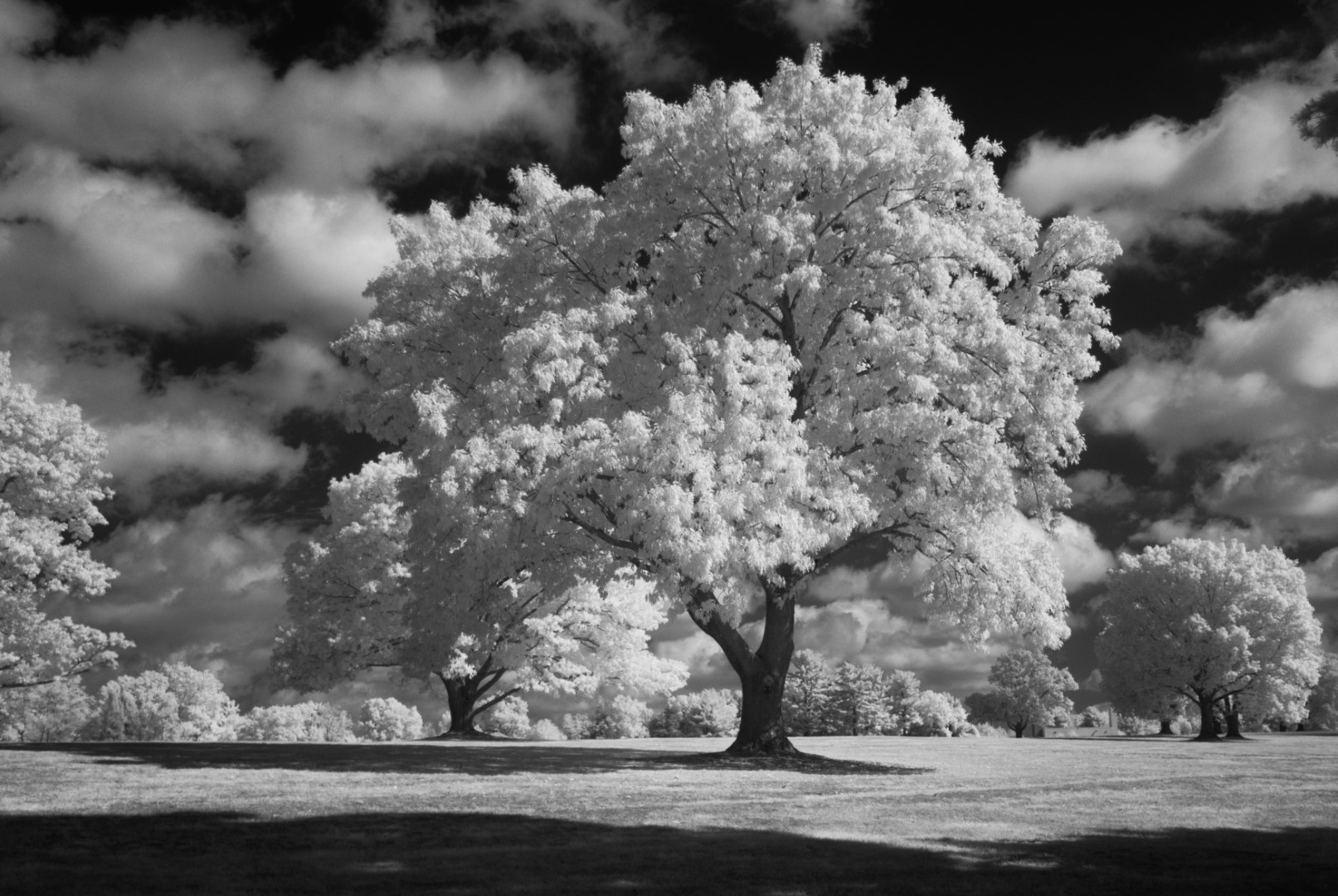 | N/A |  | 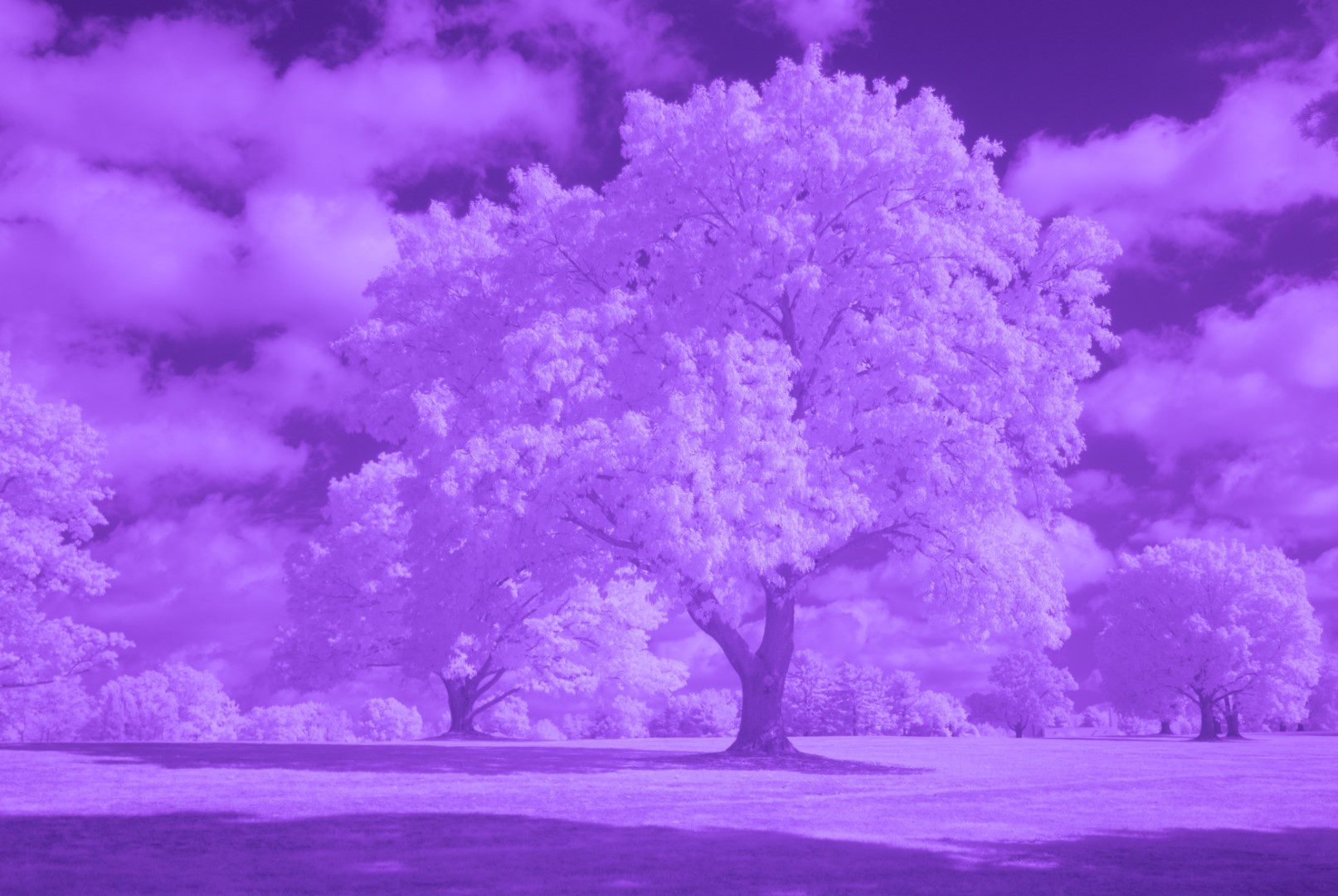 |
1000nm Filter | 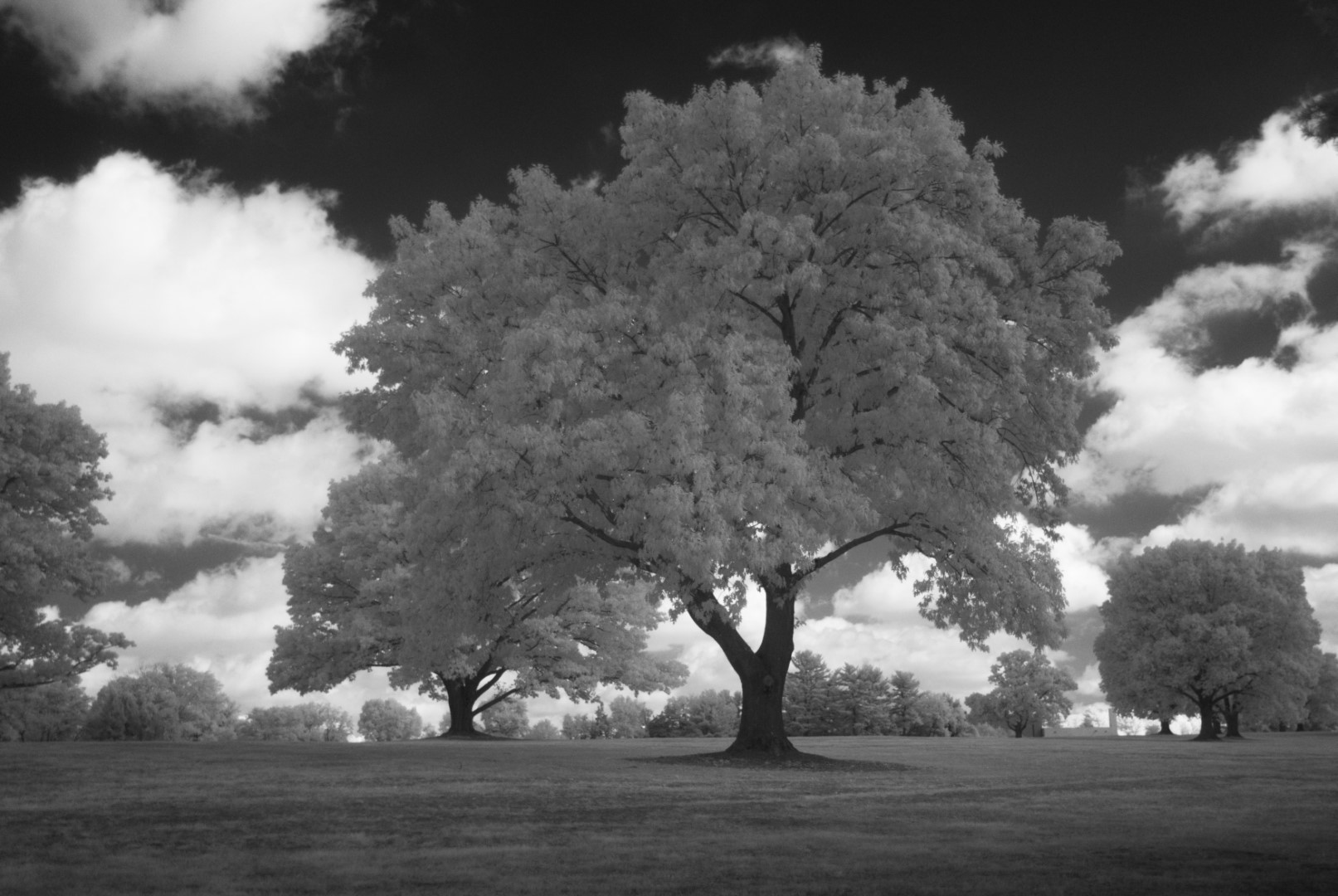 | N/A |  | 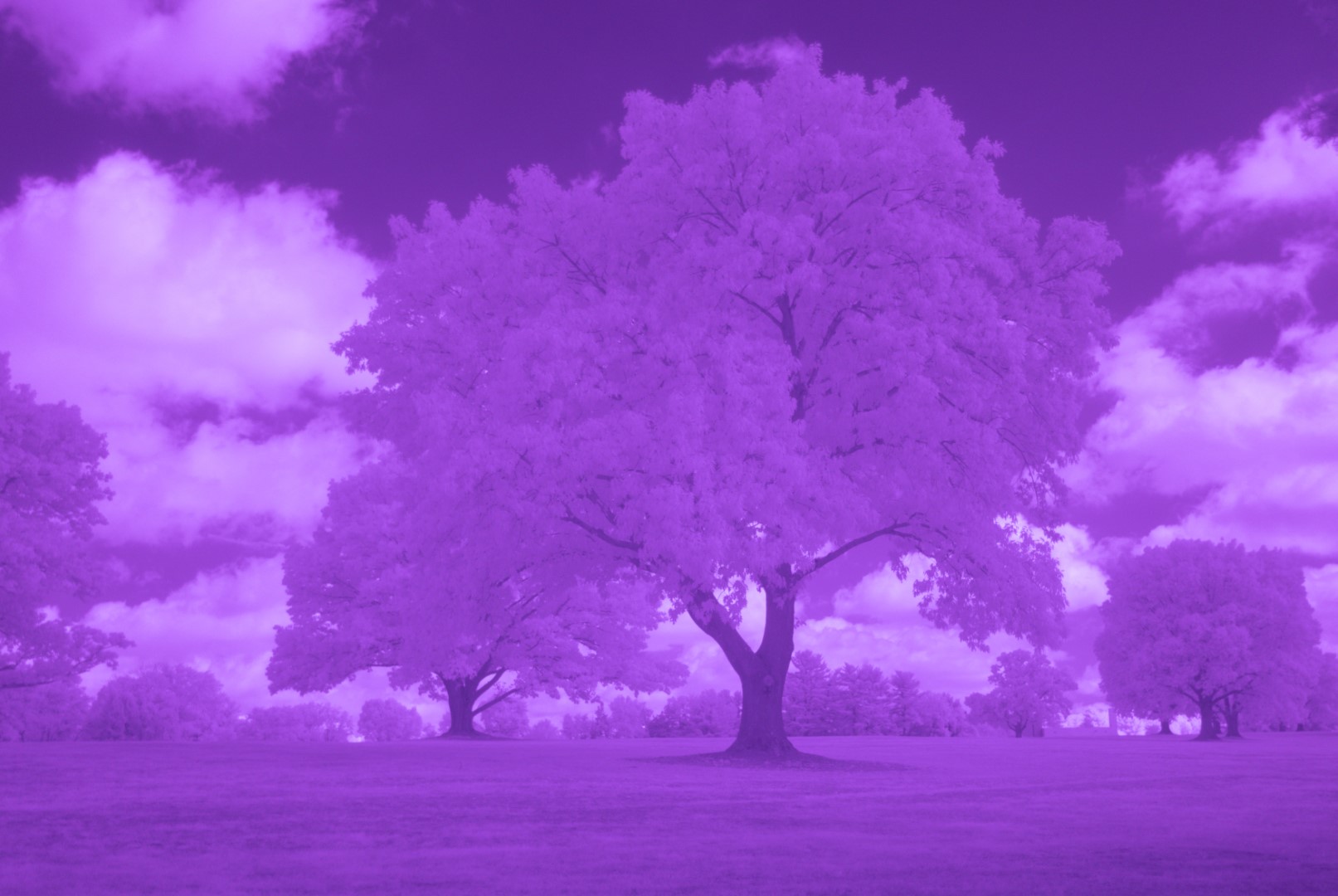 |
Blue IR NDVI |  | 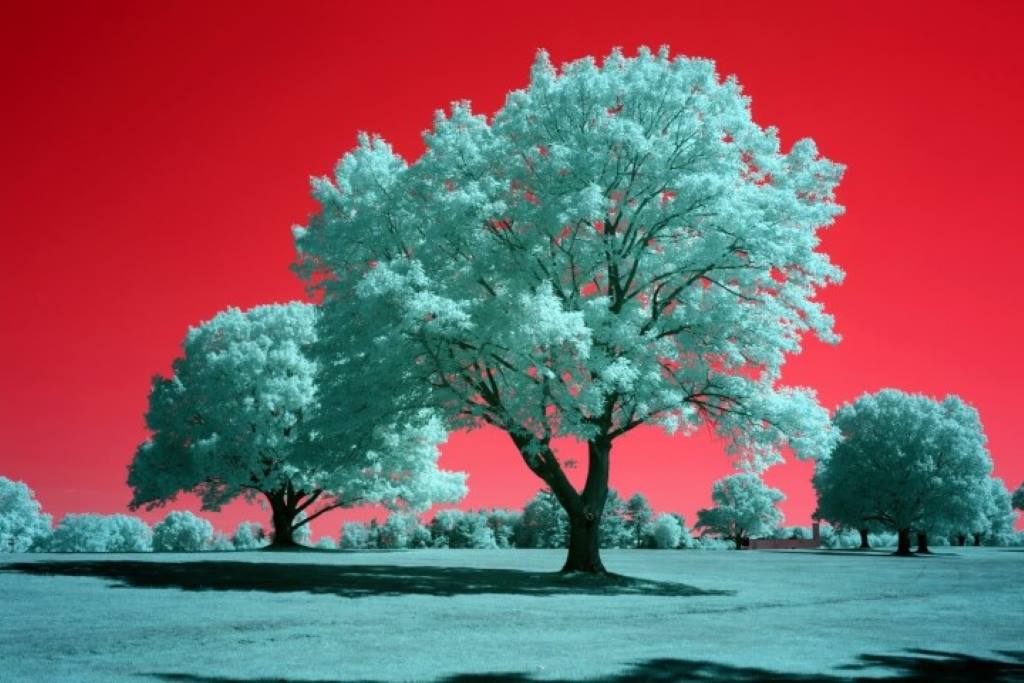 |  | 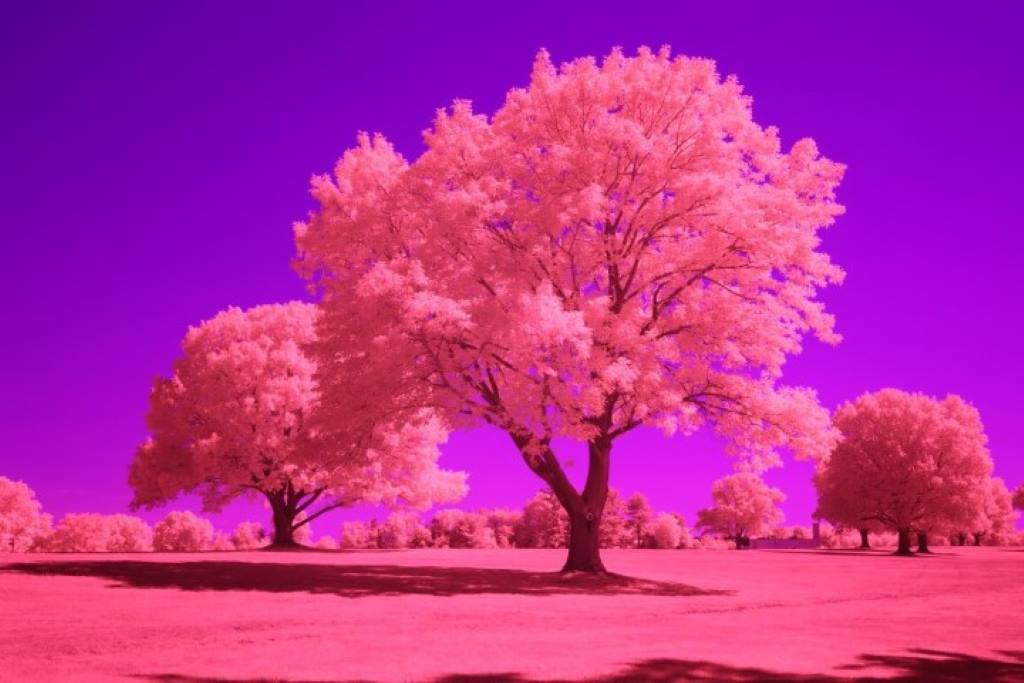 |
Full Spectrum | 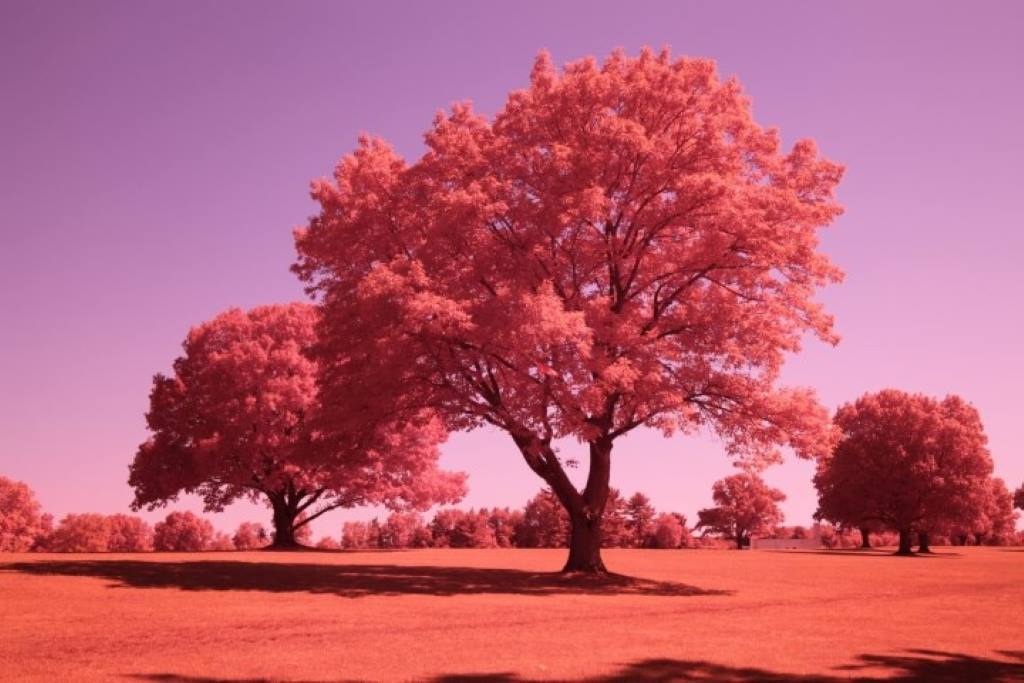 | 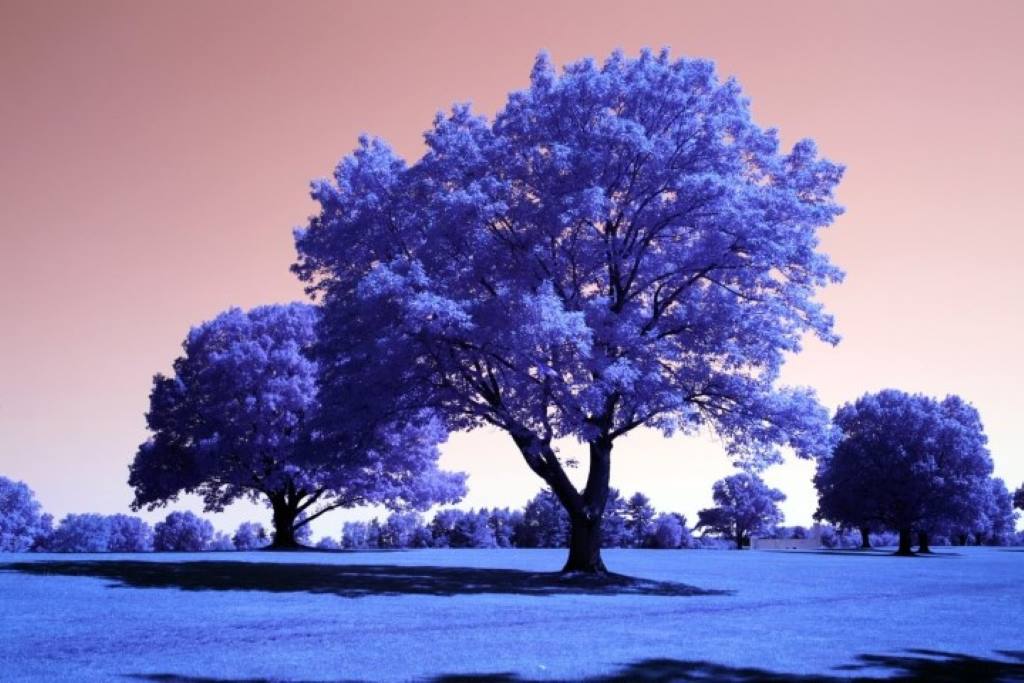 |  | 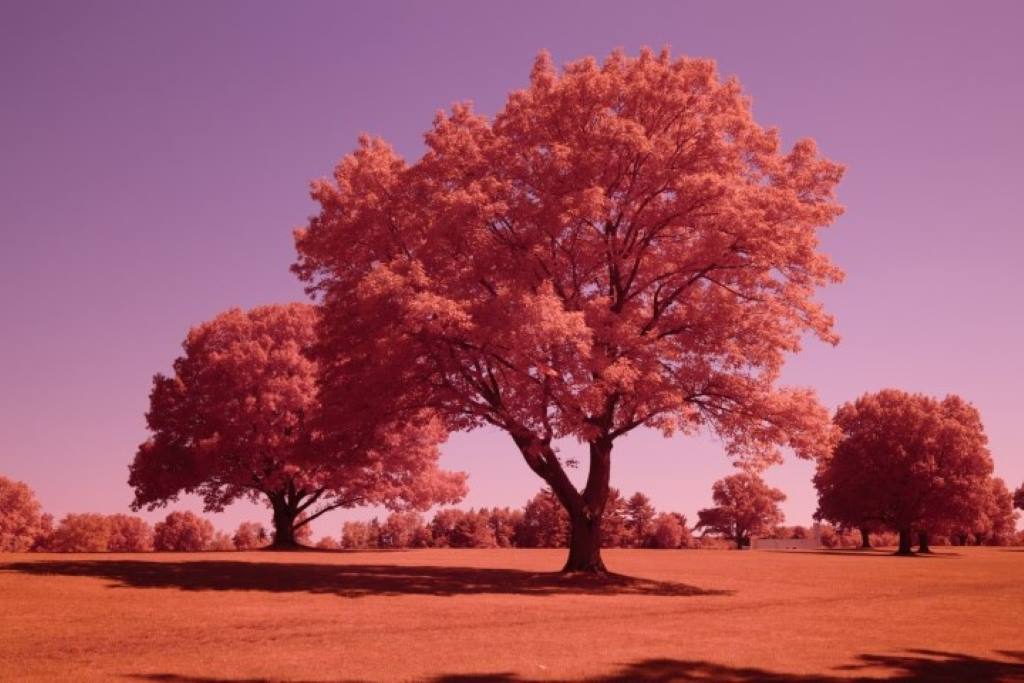 |
IR Chrome | 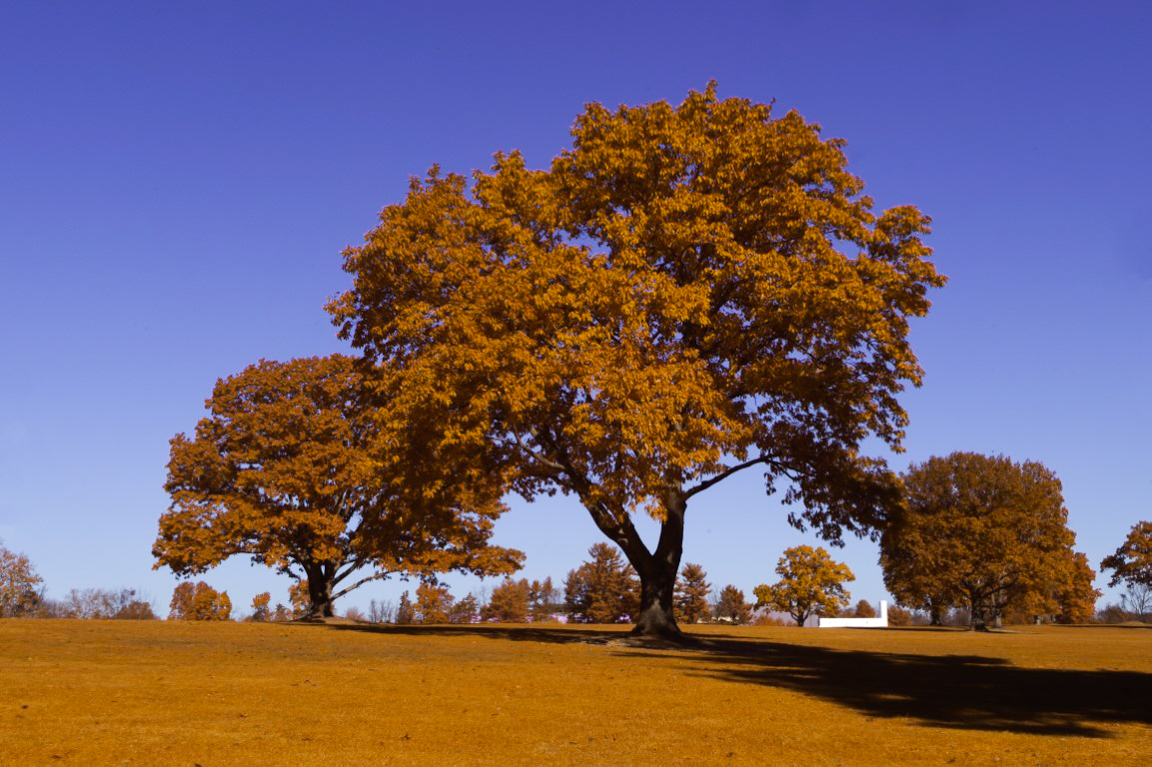 | N/A | 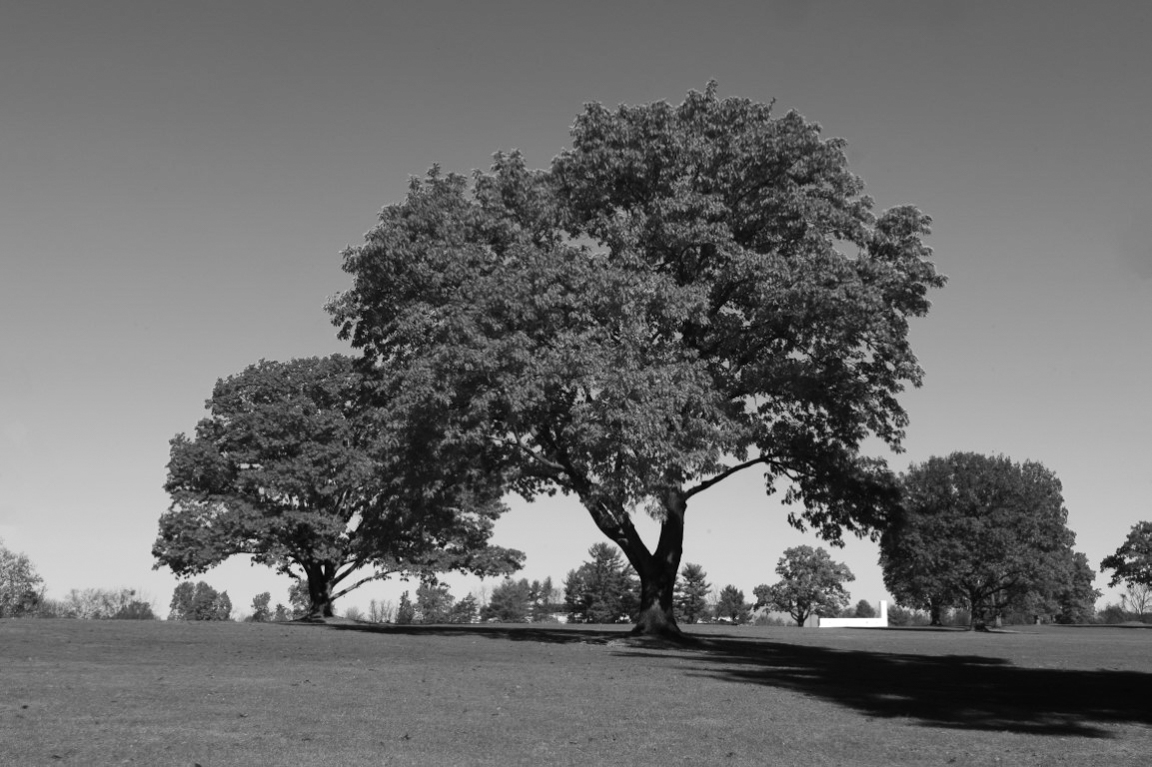 | 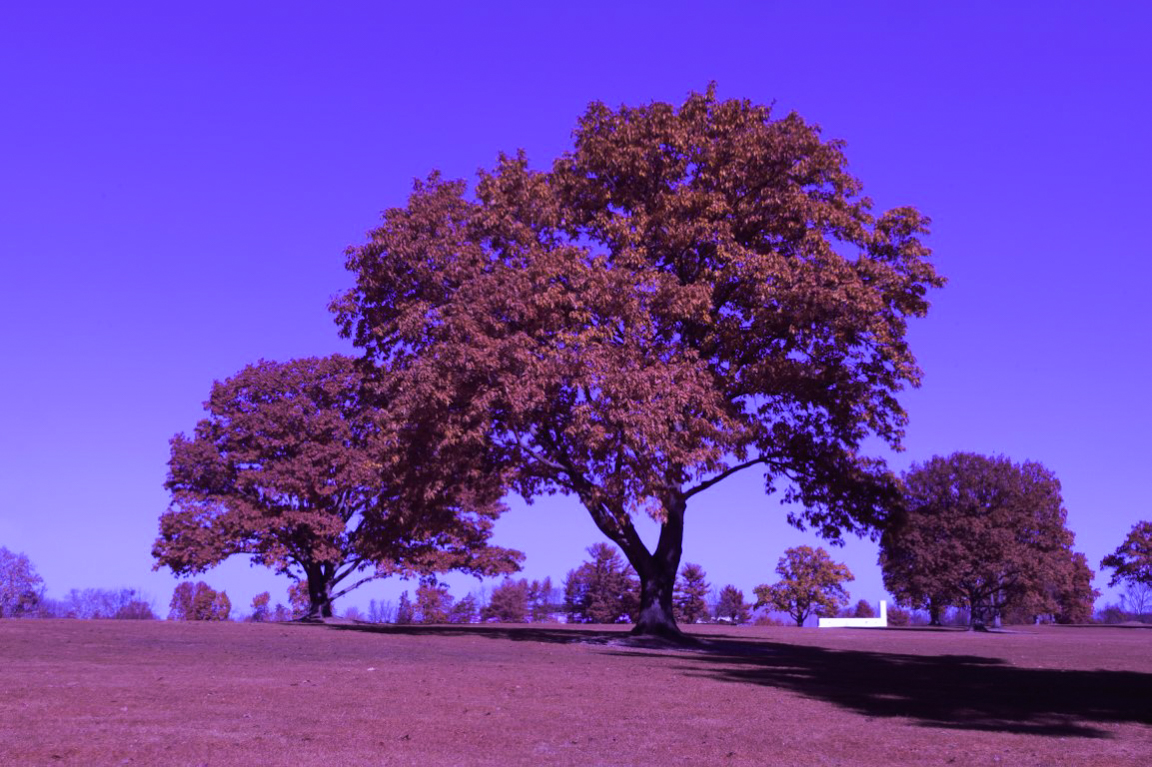 |
IR Chrome Lite |  | N/A | 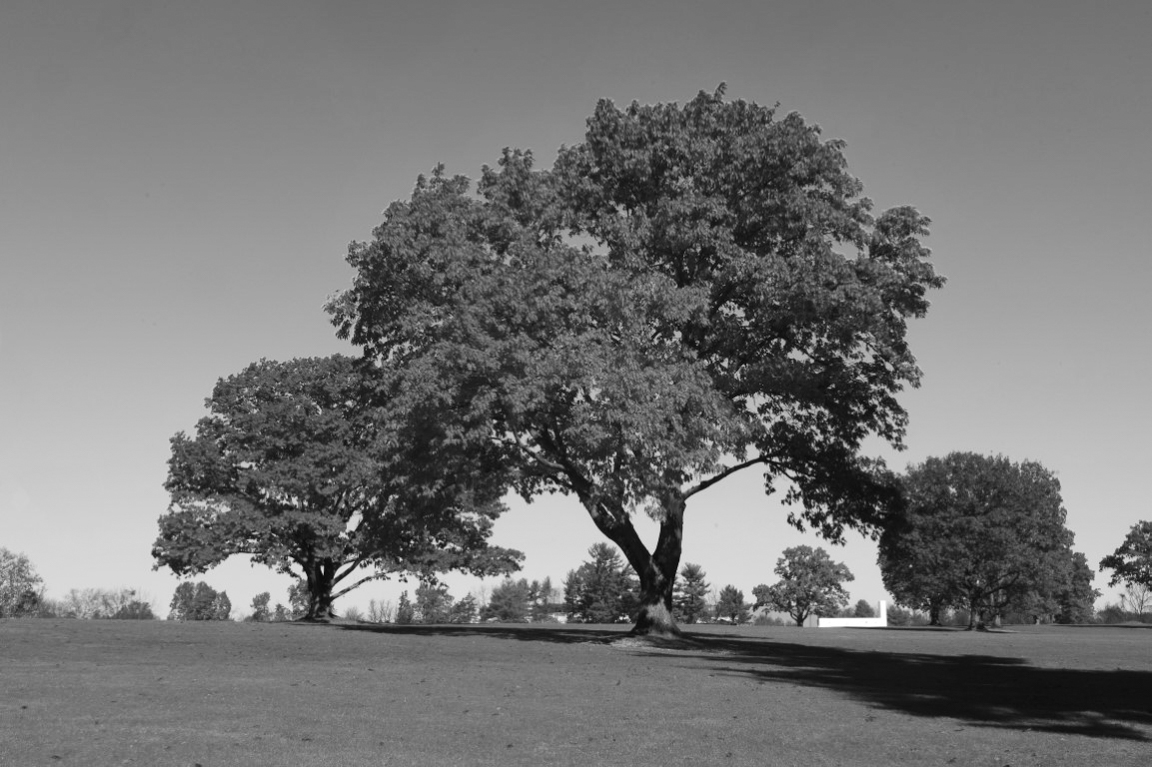 | 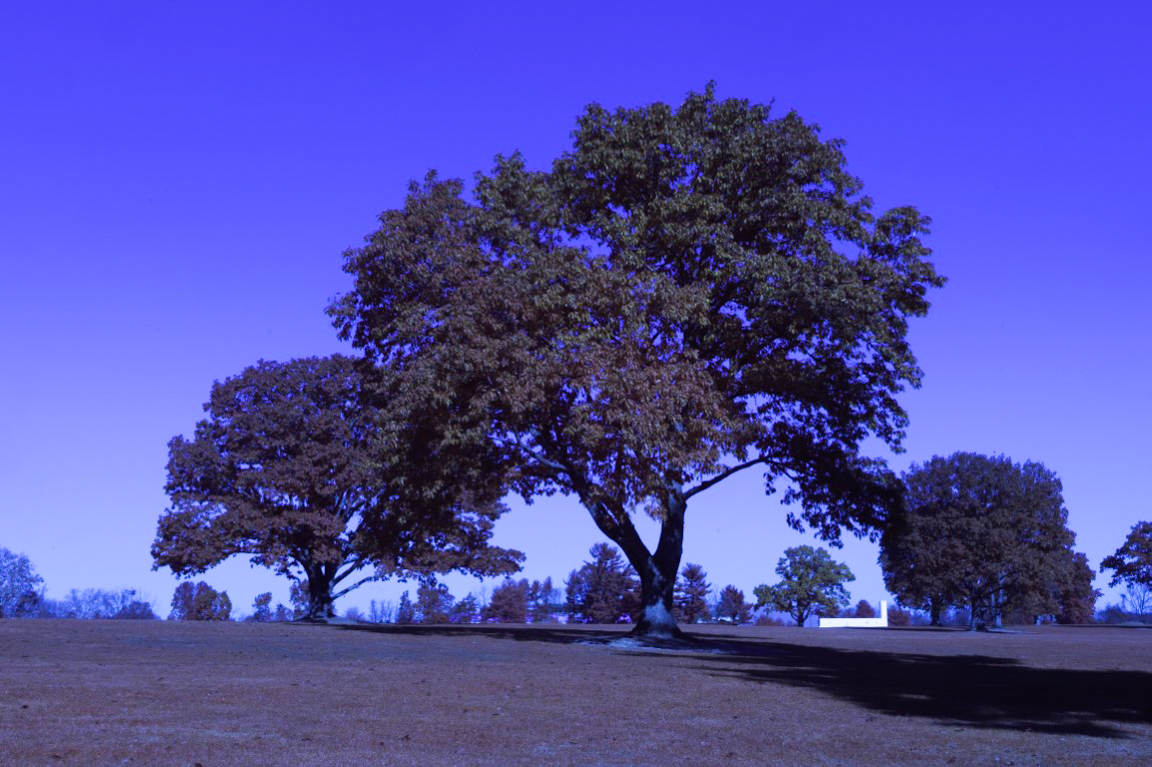 |
Iridium |  |  | 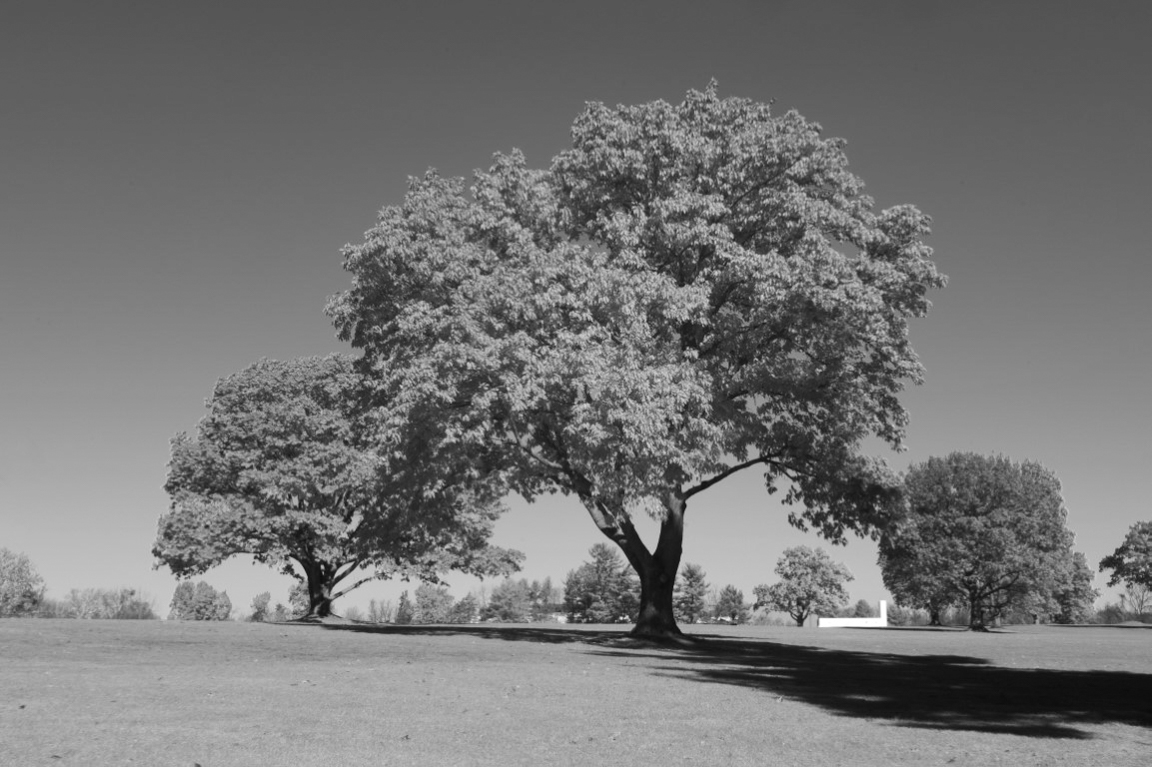 | 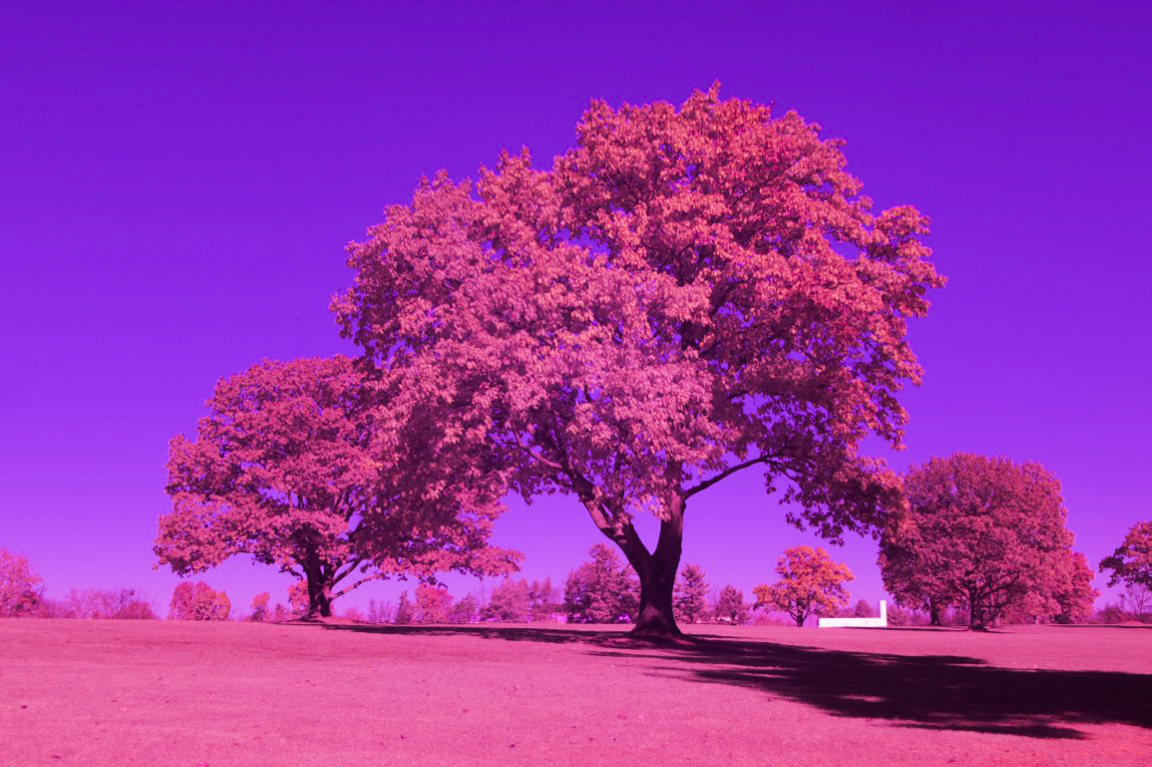 |
Considerations for choosing an infrared filter
The first thing to consider is whether you will shoot color or not.
If you plan to shoot only B&W, then the 850nm filter is the best choice. If you plan to shoot color even occasionally, you should go with the 720nm ir filter or below.
When choosing between 590nm, 665nm, and 720nm, the first consideration is your aesthetic preference. If you like the yellow leaf effect, you should choose the 590nm or 665nm option. If you want to shoot regular color shots with white leaves and blue skies, then the 720nm ir filter is probably right for you.
Pros and Cons of the 590nm and 665nm ir filter
With these enhanced color filters, you will have an increased color range to work with. With processing, it is possible to desaturate photos from these two filters to look like the 720nm image.
This adds more flexibility when shooting and allows for good color results in some shooting situations that would not work so well with the standard 720nm filter.
Some cameras don’t have very good color results with the 720nm filter, such as the Nikon 5400 and some Canon PowerShots, but the 665nm filter can overcome this.
Another nice benefit of these filters is that you can use higher cutoff IR filters over them.
For example, with a 665nm conversion, you could use a 720nm or 850nm and still take handheld pictures that will look exactly like the higher cutoff filter.
However, you couldn’t use a lower filter, like the 590nm filter. If the camera you are converting has live view, this is an easy way to take advantage of both the color and B&W aspects of IR.
A downside to these two filters is that they have less contrast for B&W images.
These filters can be more unpredictable, yielding different results depending on the camera model and shooting conditions.
Cameras will also have a harder time setting a white balance with the enhanced color filters.
Another thing to watch out for is that the 590nm and 665nm filters can be a little less sharp than the 720nm and 850nm filters. Since they let in a broader light spectrum, there are more chromatic aberrations and a bit softer focus.
Considerations for point-and-shoot cameras
The replacement filters on most compact cameras need to be very thin and leak more visible light, so 590nm, 665nm, and 720nm filters can produce duller color.
The 850nm filter will also leak a little visible light. They will still be monochromatic but may be red or blue-tinged and require processing.
A custom white balance is crucial to achieving a good false color effect with the 590nm and 665nm filters. You should only order these filters if your camera has a custom white balance option.
Keep in mind that just because your camera has a custom white balance setting does not guarantee that you can achieve images like those above with these filters.
Camera white balances were not made to work in infrared, and the camera may not be able to measure a white balance correctly, leaving you with unexpected results. 590nm filters have the most trouble with this.
If your camera does not have a custom white balance option, the 850nm filter still works for B&W photography. The 720nm filter can still be used to get good false color results even with auto white balance, although the results are not quite as reliable.
Full Spectrum
The full spectrum, or clear filter, does not have many distinct uses on its own, but rather it gives you the flexibility to switch between different external infrared filters and still shoot handheld. It makes the camera sensitive to visible, infrared, and UV light. See our Full Spectrum article to see when you should consider full spectrum as an option.


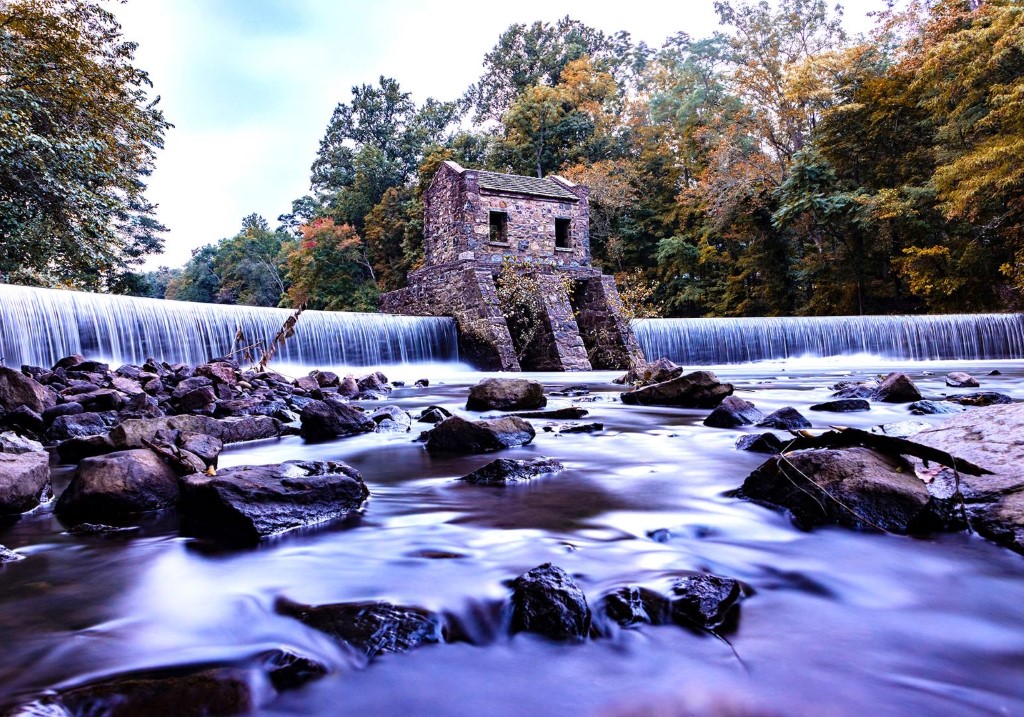
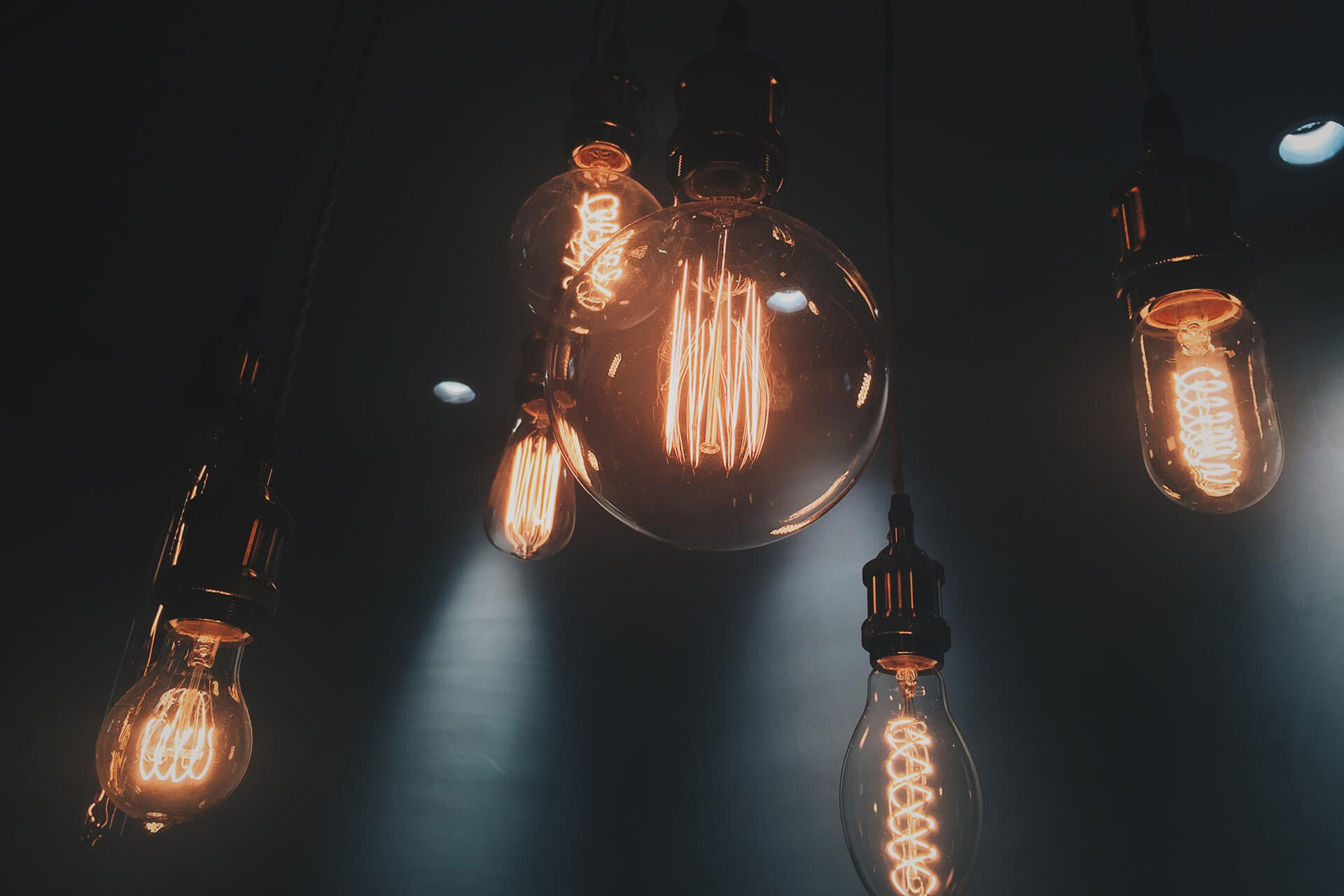





58 Responses
what is NAKED CONVERSION ?
Really nice article.
I´m currently using a Nikon D750 with a R72 on a 24-70. I use it for both color a B/W. For some reason the hotspot are very large, A hexagon in the center and a wide line across the horizon.
Well, most of the time is when I Shoot higher than F9, I know it is better at wider apertures but, hey, worth to try 🙂
Many thank for the good article.
Best regards.
in the Good Performer lens list, some of the lenses don’t accept filters. how can they be good performers if they don’t accept filters (unless there’s an adapter for a type of cokin square filter).
Our infrared conversions install an IR filter over the sensor, so that you don’t need to do any additional filtering at the lens level. It’s one of the benefits of converting to a dedicated filter, you can shoot infrared with fisheye lenses and lenses that don’t accept a filter!
Thanks for that informative article, it helps a lot.
Currently I am thinking to convert Nikon D5000.My interests are between 665 and 720.Can you please recommend the best grade for D5000, based on already converted users feedback and also with your invaluable know-how?
Thanks, hary
Hi Hary,
The 665 or 720 will both work on the D5000, but the D5000 will unfortunately not set a white balance with either filter. You would need to shoot RAW and set a custom white balance in software to get false color.
In the photo examples, I note banding in the dark converted skies.
How can this be avoided?
Is the banding inherent to the camera or the conversion?
Can it be blended out?
Thanks in advance.
Hi! I have a Sony a55 that I’d like to convert to 665nm. Will it custom white balance?
Yes the A55 will white balance well with the 665 filter. Just be careful about the SLT system. kolarivision.com//kolarivision.com///articles/sony-translucent-mirror/
What are your thoughts on the Olympus EM 5 mark 2 with a 665 filter. Will I have white balance problems, and what do you think about shooting video in IR? Thank you
That camera will work great with that filter and won’t give you problems with video.
I have the same camera. I have a full spectrum converted camera. I have IR Chrome, 550mm orange IR. Will I need to post process images. Will the 720nm and 850nm work with this camera? Will I need post processing on those images? Thanks!
I’m considering converting my Sony a7r with either the 665 or 720 filter. Would that work well? I want capability for both B&W and some color. I don’t mind having to post-process to get the best results. I can set custom WB in the a7r and that has worked well for other applications such as shooting stars at night.
Am I correct in understanding that if my camera is converted to 590nm I can gain the effects of 665, 720 and upwards by simply adding a special filter to the lens? What if any are the drawbacks in doing this? Can I go as far as the Blue IR NDVI filter?
That is correct. The main drawback is that you will lose your optical viewfinder since you won’t be able to see through the lens anymore. You would need to use live view to compose and autofocus with a filter on the lens. On a mirrorless camera there are no drawbacks. The Blue IR filter would not work over the 590, that is a multi-bandpass filter that only works on full spectrum.
In looking at the filter table above, what does the “Channel Swapped” column mean.
This means it was post processed to swap the channels. Usually this involves remapping red to blue, and blue to red, to make the red sky that you see directly out of the camera look blue. We have several tutorials on how this works and several actions that make it a one click process in Photoshop.
I use Capture One for all my post processing. I don’t own Photoshop and really don’t want to purchase it. Can Capture One Handle “channel swaping”?
yes, there are videos on it on YouTube.
Question: other than more color being passed in the 550nm, what are the main differences between the 550nm and the 590nm? By the examples given, it seems that foliage is redder in 550nm than in 590nm; is this because of the way it was post-processed or it is inherent to the filter itself? In other words: in 550nm the same foliage will show up red and in the 590nm in yellow?
If I have custom white balanced with the “standard” filter on the lens, will I need to re-custom WB when I change the filter to different wavelengths?
I want to replace my ancient F/T IR Canon D60 (not 60D) with a conversion of my Canon 5D Mark 2. I want this for only black and white work.
My favorite full frame mid range zoom lens is the Tokina 28-70mm f/2.8 (Japanese version of the Tokina 28-70mm f/2.6-2.8 lens. Not the Tokina 28-20mm f/2.8 SV model)
Will this lens work with the 850mm IR filter? If you don’t have that information, could I shoot with the Tokina using my F/T IR D60 and see if I get hot spots. If there is no hotspot on the D60 images, could I be confident that there will not be any appreciable hotspots on my 5D2 images with this lens.
Do I need to send the lens to you.?I don’t want to permanently change the lens to F/T IR use. It has IR marks on the focusing scale for 28-50-70mm. The 5D2 also had live view AF capability.
Will these filters work on a camera that is NOT converted?
Only the 720 can work on a stock camera, the rest require a camera conversion or full spectrum camera.
Hello ? …. I have a canon 5D SR and a Nikon D800 …. neither have been converted a dedicated ir camera ….. BUT will your range of ir filters work and allow me to enter the world of quality infared photography ??????? ?
Cheers Mike Ryan (New Zealand)
With a 720nm conversion, is it possible to post-process an image so it would be the same as if an 850nm conversion were made?
I have a Fuji Xt-1 Mirrorless and would like a 720n conversion. Can this be done and would I be able to set a custom white balance with this camera. Do you also clean cameras in addition to installing the ir filter?
Thank you
Does the Blue IR NDVI is compatible with Canon M6 ?
Yes! It is compatible with any full-spectrum converted camera.
What happens if I have a converted Canon G-10(720) and I use a another Ir filter in addition to the built in filter? I have a couple different range filters- I realize I will not be able to see after I install the second filter- I would be tripod mounted, and composition ready before installing the second filter.
Thanks!
With a 720 converted camera, you could apply deeper filters like the 850 onto the lens, and get the 850 look. You would still be able to compose and see through the lens filter, no need for a tripod!
Do any of these IR conversions work like night vision IR or are they just for IR photography?
After a camera is converted to IR, it will be sensitive to Infrared lights which makes it very handy for night filming/shooting things that visible lights would normally disturb such as wildlife. Regarding raw, unassisted nighttime performance, a Full-Spectrum converted camera shot without any filters will roughly double a cameras low light sensitivity. This is especially powerful when used with strong low-light cameras such as the Sony A7S line.
What custom WB balance is recommended? Are Kolasin filters available in South Africa. Just had a Canon mirrorless converted to full spectrum. 52mm lens. What filter would be recommended for IR.
Hello — I’m planning on having a Sony a7 converted, with the 850nm filter for strictly monochrome shooting. My primary lenses are 21, 25, 35, and 50 mm Zeiss Loxias, with the 25 being the most used. Which of those lenses would be the best to send in for calibration, in order to achieve the best compromise for all? Thank you!
Adapted lenses cause the most problems with post-conversion focus calibration. All of your native E-mount lenses will work perfectly after a single standard focus calibration, but if you use any adapted lenses I recommend sending those in with your camera so that they can be custom calibrated.
Just as a note, Zeiss Loxia lenses are manual focus. So, I think the answer to this particular question is that nothing special needs to be done to use these lenses on an adapted camera??
Hi,
I’m thinking of converting my Nikon D7100 to infrared using the 850 nm filter. I can also enclose a 50mm. 1.8
lens. I’m interested in taking landscapes- like Joshua Tree. If I do this can I also use my 24-70 Nikon lens with
this D7100 camera?
Thanks.
Are there any downsides to converting a Nikon D300 to 720 and then using an 850 filter on the lens?
None at all! It will work identically to an 850nm converted camera in this configuration.
Hello, can you please tell me if either of your filters will allowed me to create images with false color with my Canon OES 5D Mark III? I am talking about not changing anything on my camera so I can use it for regular photography. Is this possible? Also if your answer is yes, where can I find the filters? B&H, Adorama, etc?
Thank you for your time
You can use the 720nm without converting your camera in order to get some false color.
Hi, I’m planning to convert my Nikon D7100. What filter can you suggest that will work best with it?
This was very informative and quite helpful. I am fascinated with this technology.
Thank you
I am planning to convert my Nikon D600 to dedicated infrared and want both B&W and color capability. Does my camera have custom white balance capability? If I choose full spectrum conversion, do I still need many infrared filters? I want as little post production work as possible! Also, what is the advantage of the anti-reflective and anti smudge filter?
Thanks,
Jasmine
Hi. This is a really useful article. I’m thinking about a filter for a Lumix G5, having progressed to a Sony as my main camera. Are there any recommendations as to what can or can’t be done using it on a Samyang wide angle lens?
thanks very much
Are IR Chrome images included in the thumbnail table above?
Does the IR Chrome have a nanometer rating?
Thanks!
What about a Minolta x-700? Or canon AE-1?
Hello,
I want to shoot UV photographs to show the degree of coverage of a good sunscreen on the skin.
Kindly recommend a full, not to expensive set up that can get this done
Hi. Do you plan to manufacture clip-type filters, such as astronomical ones? if not, it is possible to request rectangular filters on demand of a requested size (to adapt to a clip).
I have the Mavic 2 Pro and am wondering if the converted camera in full-spectrum configuration will rival the IR performance of say the Mavic 2 Enterprise Dual for Search and Rescue operations.
I have a fujifilm XT3. Will a 720 be ok mainly for black and white
Thank you for the article. Still a bit confuse though – I have 720 converted camera body(mirror-less Canon M 5). What is the best way to get the look of 590nm filter now?
Thank you!
Would I be making any huge mistakes wanting to convert a Nikon D810 to 590? And, I want to verify the veracity of being previously told that with the 590 you can adjust in Photoshop to emulate the same looks up to 720?
Thanks for your time.
Thomas
Hi, I want to do the 550 nm conversion on a Nikon D5600. Will it custom white balance? I need it for portraiture in nature. Can I not shot in RAW? Thanks.
hey there.
i have a question. I shoot film mostly and I have 500T (3200 kelvin) film that i would like to try infrared with. How should i go about it. Would I get something usable?
thanks
Hello guys!
I want to use 745-765 nm filter.
I din’t find any service offering this type of conversion so I decided to use Zomei Lens filter.
What type of conversion should I order – Full Spectrum or pobably any other IR Conversion will be compatible with 760 nm lens filter? (This camera will be dedicated IR device).
Thanks in advance.
I own a Fujifilm X-T1 IR. If you don’t know, it’s a full spectrum camera straight from Fuji. I just recently bought the IR slim and could not find any information about XT1 lens fits.
Lenses that fit the Fujifilm X-T1 IR with the IR Chrome Lite; 56 mm 1.2 version 1, 16-55 mm f2.8, 16-80 mm F4. TT ARTISAN 25mm f2.
Lens that I own and did not fit the X-T1; 16mm f1.4, 23mm f1.4, 23mm f2, 35mm f2,